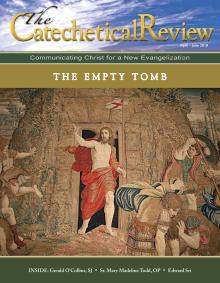There is probably a screen in the middle of your living room. There has been a screen in the middle of American living rooms since the 1950s. Its presence rearranged furniture and changed the focus of the ones sitting in those chairs—no longer looking at one another, but pointed at that screen.

There is probably a screen in the middle of your parish youth room or classroom, too. Maybe it is a large white screen built into the wall with a 4K projector, or an old console TV precariously perched atop a moving cart. It wasn’t always at the center, but over the past five-to-seven years it crept into the middle and redirected the focus as video-based catechesis has presented itself (perhaps unintentionally) as the solution to many challenges we face in ministry.
Organic and Dynamic
Certainly, the rise of video-based catechesis offers the potential to educate and bless countless souls. Multiple high-resolution video resources and platforms are now available, seemingly fulfilling a call put forth from St. John Paul II in Catechesi Tradendae when he encouraged us to think bigger, saying, “catechesis needs to be continually renewed by a certain broadening of its concept, by the revision of its methods … and by the utilization of new means of transmitting the message” (17). This vision was not without warning by the great saint, however, as later in Catechesi Tradendae, he made a point to thank, affirm, and encourage actual catechists and the irreplaceable function they serve within the Church and society. “Churches that are flourishing today would not have been built up without them (catechists)” adding that he “rejoice(d) at the efforts made… to improve more and more the training of catechists” (66). Saint John Paul II then offered a personal word of gratitude to his own catechists who were so instrumental in his formation. It is in the “faithful witness of the Christian life… day-to-day” that the faith is imparted (68).
Prophetically, the Holy Father had pointed to the need for an organic and dynamic, yet systematic approach to catechesis. He urged us to adopt various media and note trends of the day without losing the personal, pedagogical character so necessary within an effective catechetical relationship. How many of us so rooted in our faith today would not have become so without faithful, humble souls willing to walk with us and unpack each mystery with patience and perseverance?
Due to time constraints, budgetary woes, and just a plain “lack of laborers in the vineyard,” more and more parishes are opting for a digital solution to their catechist dilemma. The option of putting a well-known Catholic evangelist or respected theologian seems cleaner, safer, and more practical than finding, training, and empowering a parishioner with less education or natural speaking ability.
Now, catechist formation does come with challenges, to be sure. “I can’t find any volunteers” becomes the rally cry for many parish ministry leaders. “There are too many hoops to jump through on a diocesan level to get them certified,” another may offer. Or, perhaps, “I have people with the heart and the willingness but not with the theology” is a phrase we’ve heard all too often.
All of these points are valid and legitimate, certainly, but they also constitute a potentially dangerous situation for the future of our Church.
A Tool for the Journey
Video and digital catechesis—as theologically sound, high quality, and effective as they are today—are meant to be an aide to catechists, not to replace them. Speaking as someone who has even written, produced, and hosted several digital, video-based curricula and learning systems over the years, as a catechist it was never my hope nor my intention that such works would take the place of a live facilitator long term. Modern video catechesis should act as a supplement in a ministry setting or classroom but cannot be allowed to render live catechesis, interaction, and discipleship extinct. Video catechesis is helpful in setting up a discussion, breaking down a topic, or eliciting greater thought. Digital resources fall short, however, if not preceded and followed by ongoing relationship development, prayer, practical application, and ongoing mentorship.
Whether at a parish or within a parochial classroom, this is especially true in a youth ministry setting. Young souls need catechists who are living witnesses ready and willing to enter into real (not virtual) relationships. The next generation needs core members who, though they might not have a degree in Theology, have a willingness to put the work in to solidly break open a theological truth, even if it is through a simple teaching or small group discussion. As flashy, efficient, and “easy” as digital catechesis might be, no screen can replace the soul-to-soul contact that is a foundational part of the catechetical process and pedagogy.
A teenager in a parish setting might be enthralled by a charismatic presenter like Fr. Mike Schmitz, for instance, but when that teenager’s grandmother suffers through a painful bout with cancer, it’s not Fr. Mike who can come to the parish and walk that young soul through the harsh but beautiful reality of redemptive suffering. People need catechists not just catechesis. The term pedagogue, derived from the Greek paidagōgos, meaning “boy’s guide,” presupposes human interaction and encounter as it commonly referred to the slave or hired hand who would accompany a child to school and back. Without an actual person walking with and discipling students, there is no true pedagogy. Discipleship does not happen merely by “pressing play.” This is a critical facet to ongoing evangelization and catechetical efforts. At Life Teen we believe so strongly in this truth that we’ve partnered with Franciscan University to provide ongoing catechetical training—steeped in relationship development—to ensure that all who seek a Certificate in Youth Ministry are reminded of the importance and indispensability of living witnesses handing on the Deposit of Faith.
There is probably a screen at the center of your youth room, but perhaps there shouldn’t be. While you may not be able to change the design or function of the space, you do control where the focus goes. It is only through intentional relationships with teenagers that we can direct them toward Jesus Christ—and that won’t happen fundamentally or solely through the digital entryway. It happens in the messy moments, the mediocre conversations, and the small group discussions that break open truth. The Gospel is shared through the power of a face-to-face relationship and the conviction of a soul-to-soul conversation. We don’t need to get rid of the great tool that digital media can be for ministry, but we must never mistake it for the message.
Mark Hart serves as Executive Vice President of Life Teen International and as a frequent presenter at Steubenville Conferences. A twenty-year veteran of youth ministry, Mark is a best-selling author, popular Catholic speaker and weekly radio host on The Catholic Channel, SiriusXM 129. You can connect with Mark online at biblegeek.com.
Mark will be speaking at the Steubenville West youth conference July 13-15, 2018 in Tucson, Arizona and Defending the Faith Conference July 27-29 in Steubenville, Ohio. Go to SteubenvilleConferences.com for more information or to register.
This article originally appeared on pages 41-42 of the printed edition.
Photo credit: Public domain image from Pixabay.com.
This article is from The Catechetical Review (Online Edition ISSN 2379-6324) and may be copied for catechetical purposes only. It may not be reprinted in another published work without the permission of The Catechetical Review by contacting [email protected]


















